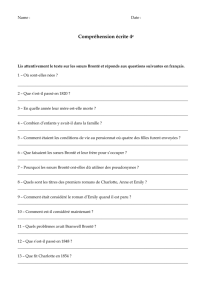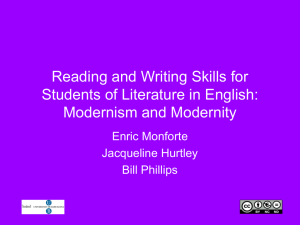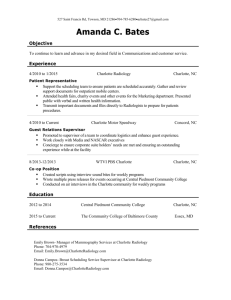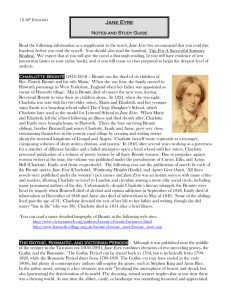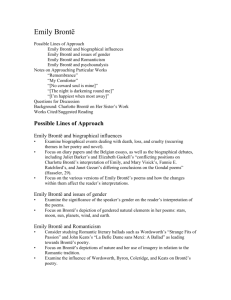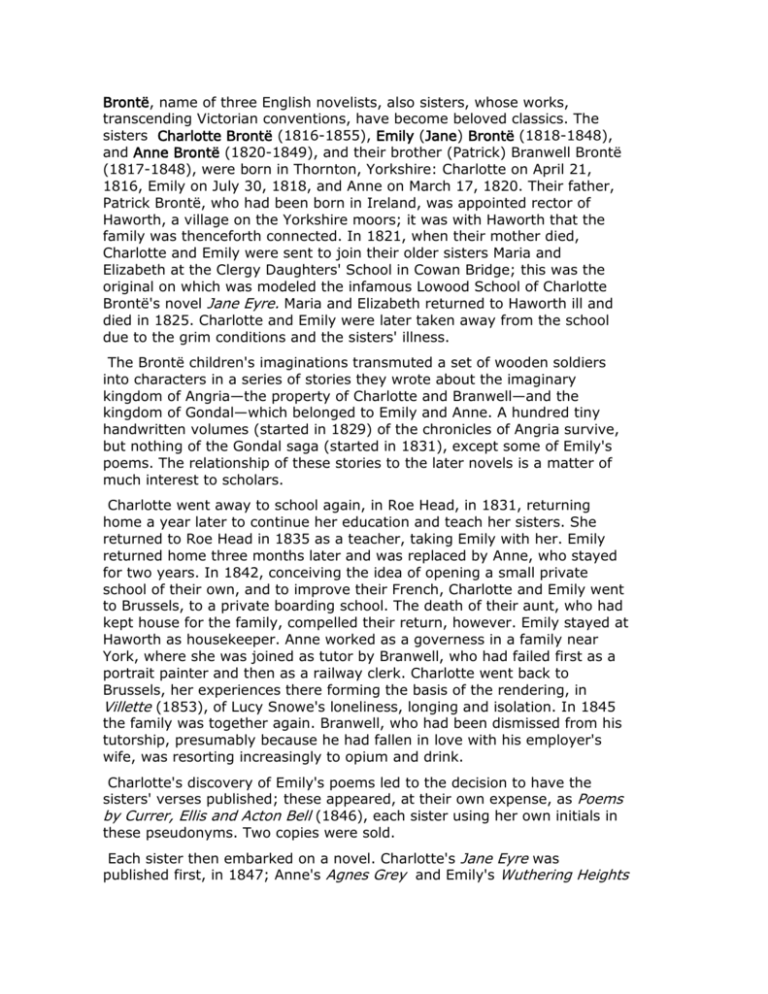
Brontë, name of three English novelists, also sisters, whose works,
transcending Victorian conventions, have become beloved classics. The
sisters Charlotte Brontë (1816-1855), Emily (Jane) Brontë (1818-1848),
and Anne Brontë (1820-1849), and their brother (Patrick) Branwell Brontë
(1817-1848), were born in Thornton, Yorkshire: Charlotte on April 21,
1816, Emily on July 30, 1818, and Anne on March 17, 1820. Their father,
Patrick Brontë, who had been born in Ireland, was appointed rector of
Haworth, a village on the Yorkshire moors; it was with Haworth that the
family was thenceforth connected. In 1821, when their mother died,
Charlotte and Emily were sent to join their older sisters Maria and
Elizabeth at the Clergy Daughters' School in Cowan Bridge; this was the
original on which was modeled the infamous Lowood School of Charlotte
Brontë's novel Jane Eyre. Maria and Elizabeth returned to Haworth ill and
died in 1825. Charlotte and Emily were later taken away from the school
due to the grim conditions and the sisters' illness.
The Brontë children's imaginations transmuted a set of wooden soldiers
into characters in a series of stories they wrote about the imaginary
kingdom of Angria—the property of Charlotte and Branwell—and the
kingdom of Gondal—which belonged to Emily and Anne. A hundred tiny
handwritten volumes (started in 1829) of the chronicles of Angria survive,
but nothing of the Gondal saga (started in 1831), except some of Emily's
poems. The relationship of these stories to the later novels is a matter of
much interest to scholars.
Charlotte went away to school again, in Roe Head, in 1831, returning
home a year later to continue her education and teach her sisters. She
returned to Roe Head in 1835 as a teacher, taking Emily with her. Emily
returned home three months later and was replaced by Anne, who stayed
for two years. In 1842, conceiving the idea of opening a small private
school of their own, and to improve their French, Charlotte and Emily went
to Brussels, to a private boarding school. The death of their aunt, who had
kept house for the family, compelled their return, however. Emily stayed at
Haworth as housekeeper. Anne worked as a governess in a family near
York, where she was joined as tutor by Branwell, who had failed first as a
portrait painter and then as a railway clerk. Charlotte went back to
Brussels, her experiences there forming the basis of the rendering, in
Villette (1853), of Lucy Snowe's loneliness, longing and isolation. In 1845
the family was together again. Branwell, who had been dismissed from his
tutorship, presumably because he had fallen in love with his employer's
wife, was resorting increasingly to opium and drink.
Charlotte's discovery of Emily's poems led to the decision to have the
sisters' verses published; these appeared, at their own expense, as Poems
by Currer, Ellis and Acton Bell (1846), each sister using her own initials in
these pseudonyms. Two copies were sold.
Each sister then embarked on a novel. Charlotte's Jane Eyre was
published first, in 1847; Anne's Agnes Grey and Emily's Wuthering Heights
appeared a little later that year. Speculation about the authors' identities
was rife until they visited London and met their publishers.
On their return to Haworth they found Branwell near death. Emily caught
cold at his funeral, and died December 19, 1848. Anne too died, on May
28, 1849. Her second novel, The Tenant of Wildfell Hall, had been
published the year before; the account of a drunkard's degeneration, it
was as deeply rooted in personal observation as Agnes Grey, the study of
a governess's life.
Alone now with her father at Haworth, Charlotte resumed work on the
novel Shirley (1849). This was the least successful of her novels, although
its depiction of the struggle between masters and workers in the Yorkshire
weaving industry a generation earlier precluded Charlotte's relying solely
on intense subjectivity. This strain of realism was the source of her power,
as can be seen earlier in Jane Eyre and later in Villette and The Professor
(1857). In 1854, Charlotte married her father's curate, Arthur Bell Nicholls.
Pregnant in 1855, she became ill and died March 31 of that year of
tuberculosis.
Since their deaths, new generations of readers have been fascinated by
the circumstances of the Brontës' lives, their untimely deaths, and their
astonishing achievements. Jane Eyre's popularity has never waned; it is a
passionate expression of female issues and concerns. The Brontës'
transcendent masterpiece, however, is almost certainly Emily's novel
Wuthering Heights, a story of passionate love, in which irreconcilable
principles of energy and calm are ultimately harmonized. Emily Brontë was
a mystic, as her poetry shows, and Wuthering Heights dramatizes her
intuitive apprehension of the nature of life.
The first book about the Brontës, The Life of Charlotte Brontë (1857), by
her friend the novelist Elizabeth Gaskell, is a classic biography. Another
notable book is Fannie E. Ratchford's The Brontës' Web of Childhood
(1941); it first indicated the significance for their art of the Angria and
Gondal sagas of their childhood.
Contributed By:
Walter Allen
1
1"Brontë."Microsoft® Encarta® Encyclopedia 2001. © 1993-2000 Microsoft Corporation. All
rights reserved.

